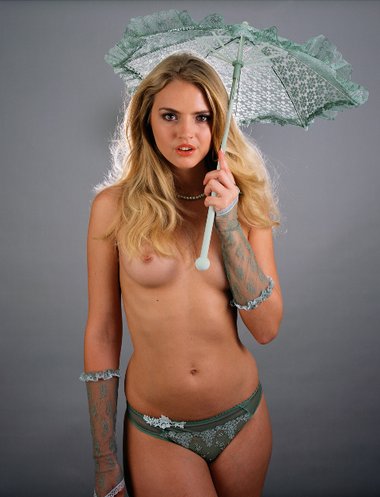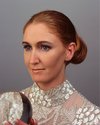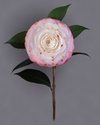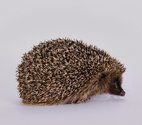John Hurrell – 6 October, 2010
Perhaps my joining up these seven images like this, weaving them into a kind of sequence, is somewhat forced, that they are independent and discrete, each with a life of its own. However moving around a confined space such as Ivan Anthony's with its four small rooms, is not the same, say, as wandering down a long corridor where they are lined up - where retaining images in your memory is not so important.
In this slightly odd group of seven works featuring somewhat inconsistent subject matter, Yvonne Todd presents two figure studies, one portrait, one animal, a flower, an instrument and its player - and a building. Whilst teasingly disparate, these - as you would expect from this artist - are intriguing, confident images, and there are linking threads. In a vague way these unite the show.
Perhaps it doesn’t matter whether they do or don’t? However I’d like to think the artist has organised her work, selectively picked it out from a pool of recent projects, rather than simply decided to display the last seven items she has created.
For example the image of the fair-haired young woman in Did Anybody Ever Tell You That You’re Pretty when You Are Angry? seems to be central because the photo connects with several other images. She is wearing knickers and ‘wristwarmers’ of the same diaphanous green material, to which the small parasol that she holds is also similar. As a semi-naked figure study she is related to a much larger male image, Gunther in the room next door. He, lean and wiry in three-quarter profile - with long hair and beard - wears only a loincloth but is smeared on his chest and thighs with what seems to be white clay.
The girl’s face is of interest because she seems slightly irritable. Her eyes are intense and her upper lip is pressed tautly against her front teeth - making her demeanour slightly rodentlike, as if she is sucking her cheeks in - something hard to do if your mouth is open. The directness of her gaze is matched by the blank stare in a third photo of an older woman looking vacantly in space after contemplating a crystal ball.
This older woman has her hair is tied in a bun which, when seen from an angle, makes up a crescent shape that reflects a moonshaped shadow in the sphere and the white free edges of her nails. She is wearing an ornate dress of tubular beads and sequins that flicker and shine with reflected light - that aspect linking to a fourth photograph out in the hallway, a beautiful pristine image of a boxlike skyscraper with its reflective rectangular glass planes dissolving in an early evening, slowing darkening, blue sky.
The flimsy, decorative umbrella the topless teenager holds, with its long handle, relates to a fifth, very formal image here, of a long stalked camellia with pale pink petals and rust coloured splotches, while the long hair of the bearded man in the second photograph I mentioned mirrors the long hair of the harpist in the sixth image. She is called, rather unfairly I think, Greasy Harpist, but her skin does seem a little shiny.
Now in this piece of writing I have been zigzagging around - like corralling a herd of cats (as they say) - describing and placing value on certain salient formal elements within the artwork. Similarly (for the last link) the golden instrument belonging to the Greasy Harpist, I’ve noticed, has a protruding loop at its top on the right, joining its curved neck and its diagonal soundbox.
That flattened loop sticking out has correlations with part of the last, seventh photograph - a gorgeous image of a beady-eyed hedgehog with a cute little snout. Its pointed damp nose mimics the tight bend in the harp.
The animal is sitting down in profile so you can’t see its skinny black legs. Positioned against a white backdrop, that reveals the tactile directions of its spiky prickles and dark whiskers, and the varieties of matted hair on different parts of its oval body.
Perhaps my joining up these seven images like this, weaving them into a kind of sequence, is somewhat forced, that they are independent and discrete, each with a life of its own. However moving around a confined space such as Ivan Anthony’s with its four small rooms, is not the same, say, as wandering down a long corridor where they are lined up - where retaining images in your memory is not so important. Todd’s images are about the particular, the unique qualities of each individual subject and her subsequent accentuation (or perhaps suppression) of detail to create a highly pleasurable variety of artificiality. It is inevitable that you compare images, overlaying and contrasting what you see.
John Hurrell







 Advertising in this column
Advertising in this column Two Rooms presents a program of residencies and projects
Two Rooms presents a program of residencies and projects



This Discussion has 0 comments.
Comment
Participate
Register to Participate.
Sign in
Sign in to an existing account.